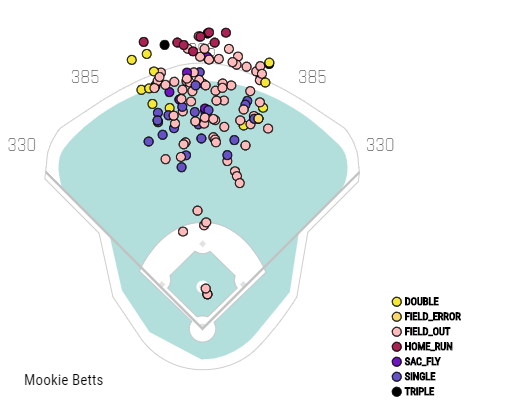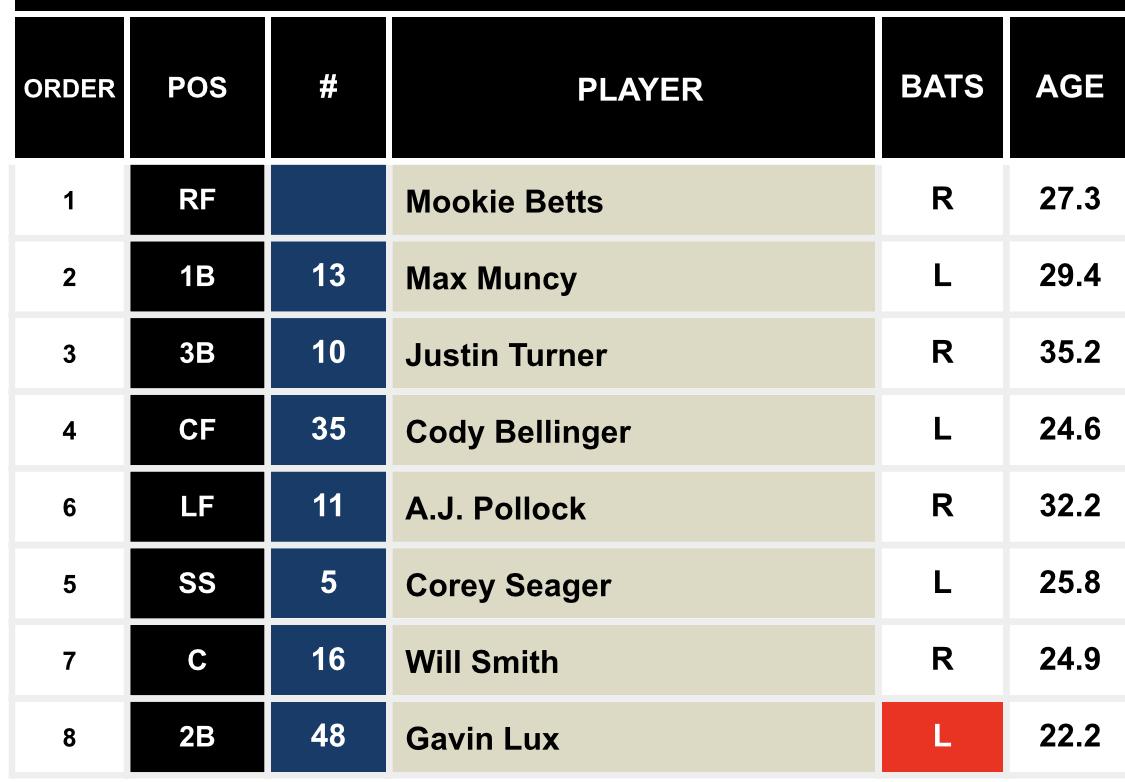Outfielder Mookie Betts and starting pitcher David Price were acquired via trade by the Los Angeles Dodgers in a blockbuster offseason deal. Brian Entrekin breaks down the fantasy baseball implications of this move from L.A.'s perspective.
For weeks there have been rumors of a potential Mookie Betts trade. It seemed Betts might be heading to the San Diego Padres, but recently another NL West team, the Los Angeles Dodgers, became involved in the trade discussions. Like most times, when the Dodgers get involved they get what they want.
On Tuesday, Mookie Betts and David Price were traded to the Dodgers as part of a three-team deal. The Red Sox were looking to shed that David Price contract (they shed half) with Betts and in return received Alex Verdugo from the Dodgers and Brusdar Graterol from the Twins.
The Dodgers made another trade after the Betts/Price deal, sending Joc Pederson and Ross Stripling across town to the Angels. The Dodgers were already National League and even World Series favorites; these trades made those odds even better. With all these roster moves, the Dodgers mixed up some playing time for others on the roster as well. Let’s look at the final impact after these trades in regard to the Dodgers.
Be sure to check all of our fantasy baseball lineup tools and resources:- Fantasy baseball trade analyzer
- BvP matchups data (Batter vs. Pitcher)
- PvB matchups data (Pitcher vs. Batter)
- Who should I start? Fantasy baseball comparisons
- Daily MLB starting lineups
- Fantasy baseball closer depth charts
- Fantasy Baseball live scoreboard
- Fantasy baseball injury reports
Mookie Betts Changing Parks
Out of all the players that were traded, Mookie Betts probably had the smallest change in fantasy value. Betts was a top-five draft pick before the trade and is still a top-five pick after the trade. Betts has been the model of consistency with the Red Sox. He has played in at least 145 or more games in four of the last five seasons. He has hit 29 or more home runs in three of his last four seasons. He has even stolen at least 21 bases in four of the last five seasons. Betts contributes in all five categories and there is a reason he has won an MVP award.
Now, Betts leaves Fenway Park for Dodger Stadium. Fenway is a great BABIP ballpark, one of the best in baseball. The good thing with Betts is that he was not reliant on BABIP for all his success as he has a career .314 BABIP, which is good but not great. When looking into the power aspects of Fenway Park vs Dodger Stadium, it becomes a little more interesting. As we know, pulled balls and, more importantly, pulled barreled balls result in more home runs. This is good as Betts is a pull-happy man, pulling the ball at least 43.6% of the time in the last three seasons.
| % BAR HR RHH | % PULL BAR HR RHH | |
| Dodger Stadium | 73.40% | 74% |
| Fenway Park | 69.70% | 67.40% |
As seen in the chart above, in Dodger Stadium right-handed hitters barreled a little less than 74% of all home runs. This means 26.6% of RHH home runs were not barreled, whereas 30.3% of home runs in Fenway Park were not barreled. Now, let's take this even deeper, and bring it back to the importance of Betts moving to Dodger Stadium. With Betts pulling the ball over 43% of the time and 74% of all pulled, barreled balls by RHH are home runs, then we can assume Betts will enjoy a slight home run boost in Dodger Stadium.
A big reason the numbers in Fenway are lower for RHH is the Green Monster. Barrels are defined as a ball hit at 26-30 degrees, so we can assume some of these barreled balls hit the monster where they would leave most other ballparks. Betts has also had at least 40 doubles in every season since 2015, which makes sense with the Monster in play.
Pulling the ball will help Betts more in Dodger Stadium, but he could see even greater power stats in L.A. compared to Boston when he hits the ball to centerfield. As mentioned above, Fenway is a major BABIP park and the large centerfield is a major reason with more room for the ball to fall. A potential power spike could be as simple as Betts' hits to center actually having more success in Dodger Stadium. Here is a picture of his hits to centerfield in 2019 overlayed on Dodger Stadium. Looks nice.
Betts is going to be great in Los Angeles, just like he was in Boston. He will likely be leading off or hitting near the top of the order of a great lineup. Last season, he scored 135 runs and he should be in line for another huge season in the runs category. He is always a solid batting average and OBP option as well. If he can take advantage of some of the new park factors that will favor his game, then watch out, as he could hit 35-plus home runs and be on his way to another MVP campaign.
David Price and an ADP That's Nice
Price is coming off another injury-riddled season where he only pitched 107.1 innings. In the last three seasons, Price is averaging only 119.1 innings pitched. Regardless of how many innings Price has pitched, he has still pitched really well though. Over the last three seasons, he is still averaging 127 strikeouts per season. Last season he had a 4.28 ERA which was his first season with an ERA over four since 2009. Even with that rough ERA, Price had a 3.73 xFIP and a career-best 28% strikeout rate. He really just needs to stay healthy.
Price may benefit in a big way by heading to Los Angeles. The biggest benefit is as simple as leaving the AL East, a division where he has spent almost his entire career. Last season Price gave up 15 home runs and 10 of those came from AL East opponents. In 2018, it was similar with 18 of his 25 home runs coming from the AL East. Most of these home runs came from the Yankees. Price will be glad to relocate divisions.
Price has also shown major home/road splits in his career, with more strikeouts and fewer runs at home and nearly 30 more home runs allowed on the road. He will now pitch in Dodger Stadium which may be a little more lively for hitters than Fenway, but he will also face some easier foes in the NL West. Price will not be traveling to Yankee Stadium, Camden Yards or Rogers Centre. Instead, he will pitch in Oracle Park, Petco and Chase Field. If he can navigate Coors Field, then the switch from the AL East to the NL West will be huge for Price.
Currently, Price is the 81st pitcher off the board at pick 201.12 when looking at NFBC ADP for online drafts since January 15. Assuming Price stays healthy and is able to throw 150 or more innings then that draft price is a steal. There is a risk, as Price has not pitched more than 107.1 innings in two of the last three seasons, but a risk that could pay off in a big way for your fantasy teams.
Impact on the Dodgers
The Dodgers offense was already one of the best in baseball and is now even stronger. They have the reigning NL MVP in Cody Bellinger and have now added former AL MVP Mookie Betts. With Betts atop the order, followed by Max Muncy, Justin Turner, and Bellinger, the Dodgers have a terrifying one through four. If the likes of Corey Seager and A.J. Pollock can stay healthy and youngsters Will Smith and Gavin Lux take the next step, then watch out for this offensive juggernaut. (Roster Resource projected lineup)
When it comes to pitching the Dodgers love to mess with fantasy owners. Walker Buehler is the workhorse and should be an ace, both in reality and fantasy. Clayton Kershaw will be the number two and is good for 150-170 innings. After the big two, there is David Price, Alex Wood, and Julio Urias, which makes for a lefty-heavy rotation. If something were to happen to any of the starters, they do have reinforcements, however, such as Dustin May and Tony Gonsolin, who are waiting for their chances to make an impact at the Major League level. Buehler, Kershaw, and Price are definite high-end targets in fantasy drafts, while Wood, Urias, and May can be later-round targets due to their upside if given the opportunity.
The Dodgers were already the favorites in the NL West and have made trip after trip to the World Series. The addition of Betts and Price may help them get over the hump and win the whole thing this time. Time will tell, but while we wait for that result, they will give us a lot of fantasy goodness.
More 2020 Fantasy Baseball Advice
 RADIO
RADIO


























